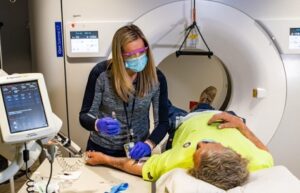
Medical imaging supervisor Christine Thalheimer assists Vietnam Veteran Bobby Richardson last year during his CT scan at Richard L. Roudebush VAMC in Indianapolis, IN. VA photo by Mark Turney
ST. LOUIS — The problem with options is choosing. Until recently, oncologists did not need to choose between treatment alternatives for stage I lung cancer. If a patient could withstand surgery, the decision was made.
Surgery remains the recommended treatment for most patients with stage I non-small cell lung cancer (NSCLC), but with other options available and potentially better for some patients, physicians now must determine which treatment is most suitable for each patient. That has proved challenging as large studies comparing surgery to the leading option, stereotactic body radiotherapy (SBRT), have yet to conclude.
Consequently, a growing number of models for predicting post-operative risk for patients with NSCLC have emerged, but they have been plagued by variable results, short assessment windows and low adoption rates in practice.
The largest integrated health care provider in the country, the VA cares for a population at high risk for NSCLC – both as a function of the age of its patients and the high percentage of veterans with a smoking history. The VA Lung Precision Oncology Program estimates that 900,000 veterans are at risk for lung cancer and nearly 8,000 receive a diagnosis of the disease each year. The VA Partnership to Increase Access to Lung Screening (VA-PALS) program is increasing the number of veterans diagnosed with early stage lung cancer, when it is most curable.
“Surgery remains the gold-standard treatment for patients with early-stage lung cancer,” Brendan Heiden, MD, MPHS, of the Washington University School of Medicine in St. Louis told U.S. Medicine. “However, certain patients, such as those with significant comorbidities, sometimes do not qualify for surgery due to their increased risk for post-operative complications or death.”
Heiden and colleagues at the VA St. Louis Health Care System and Washington University sought to provide an easy-to-use, reliable predictor of 90-day post-operative mortality for physicians to use in determining which patients physicians should recommend proceed to surgery and which they should advise to consider other options.1
The team called the model the VA Lung Cancer Mortality (VALCAN-M) score. “This VALCAN-M risk score can help surgeons and other providers to determine appropriate, patient-centered treatment options,” Heiden said.
Developing the Model
The researchers conducted a retrospective cohort study using data from all veterans with stage I NSCLC who underwent surgical treatment between 2006 and 2016. The 9,749 veterans were divided into a derivation cohort of 6,825 and a validation cohort of 2,924 patients. Patients had an average age of 67.6 years, 96.3% were male and 82.8% were white. Three out of five (58.5%) reported currently smoking at the time of surgery.
The most common comorbidities included chronic obstructive pulmonary disease (63.1%), peripheral vascular disease (44.9%). Just over 70% of patients had a lobectomy, with thoracotomy the most common surgical approach (58.5%). The majority of tumors were adenocarcinomas (53.3%).
One in seven patients experienced a major post-operative complication (13.9%) and more than half of those patients required hospitalization (7.8%). The 90-day mortality rate for the entire group was 4.0%.
Notably, the group focused on 90-day mortality rather than the 30-day window used by previous models. “Prior models have assessed 30-day mortality despite a growing body of evidence suggesting that broader time horizons—like 90-day mortality—are more accurate metrics of operative risk,” they wrote. “Indeed, studies routinely demonstrate that mortality rates following pulmonary resection approximately double from 30- to 99-days postoperatively, suggesting that analyzing only the former may fail to accurately capture perioperative risk.”
Critical Factors
Using multivariable logistic regression modeling, the researchers identified 11 factors associated with 90-day mortality. They included age, body mass index, history of heart failure, forced expiratory volume, history of peripheral vascular disease, functional status, delayed surgery, American Society of Anesthesiology performance status, tumor histology, extent of resection and surgical approach.
Of those, “the factors that were most strongly associated with post-operative mortality included patient age, functional status and comorbidity burden,” Heiden noted. “Assessing patients for these factors is important when deciding the optimal treatment strategy for early-stage lung cancer.”
The team did not include variables that could not be known before surgery, such as complication or readmission rates. They also excluded non-modifiable sociodemographic variables such as race, “since inclusion of race as a variable in risk prediction modeling has been widely criticized as propagating racial and racist disparities in health.”
The VALCAN-M scale ranges from -10 to 42, with higher scores representing greater risk of 90-day mortality. The highest points were awarded to age of 80 years (5 points), BMI below 18.5 (6 points), pneumonectomy (8 points), partially or fully dependent (6 points) and stage 5 ASA classification (6 points).
“As expected, patients who received smaller operations, such as minimally invasive operations or sublobar resections, had a lower risk for post-operative mortality,” Heiden explained.
Despite the lower risk of short-term mortality with wedge resections, the authors noted that these more modest resections also carry a higher risk of recurrence and shorter overall survival. “The optimal type of resection depends on several patient- and tumor-specific factors, and these factors should be discussed between the surgeon and patient prior to treatment,” said Heiden.
The group hopes to make the VALCAN-M score available to VA and non-VA clinicians in an accessible and easy-to-use, web-based platform, Heiden said, with the goal of aiding “surgeons and other providers in objectively discussing operative risk with high-risk patients with early-stage lung cancer considering surgery versus other definitive therapies.”
- Heiden BT, Eaton DB Jr, Brandt WS, Chang SH, Yan Y, Schoen MW, Patel MR, Kreisel D, Nava RG, Meyers BF, Kozower BD, Puri V. Development and Validation of the VA Lung Cancer Mortality (VALCAN-M) Score for 90-day Mortality Following Surgical Treatment of Clinical Stage I Lung Cancer. Ann Surg. 2022 Oct 17.

